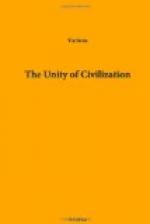What was this, then, that had come to European art and literature? Clearly what we see is the transition from the heroic world of the tragedy, from the splendid beauty and force of the Italian painters, from the infinite grace of the romantic comedy, to some other artistic apprehension of the world. The movement was not indeed wholly dependent upon a reaction, but in its development it corresponds with the reaction against the continuance of a great tradition which had become merely a convention, when it had lost its vitality and sincerity. The best examples of this may perhaps be found in Dryden’s attempt to carry on the heroic tradition in English tragedy, and in Voltaire’s strenuous and meritorious efforts to continue the work of Racine and Corneille. They meant well, and their tragic dramas are not without merit, but it is clear enough that they could not bend the bow of Ulysses. They were great artists, as we can see clearly enough in Absalom and Ahitophel, or in Candide, but their genius lay in other directions. ’Il faut cultiver notre jardin’ is a great judgement of life, one very wholesome and necessary for all time, but it was not the mood of Othello or of Hamlet.
European art had to come down from the empyrean, and though the descent was great, yet it gained new life by once again touching mother earth.
No doubt, however, the harsh reality of Hogarth and Defoe was not the whole of life, and, by a strange transition, before the middle of the eighteenth century we find the novelists and, though they are less important, the dramatists, turning from the faithful and minute study of the outward appearance and form of things to the study of sensibility and emotion, and the world, which had seemed so hard and unmoved, was dissolved in tears.
We find this a strange and even a ridiculous spectacle, the men who had prided themselves on their common sense and reasonableness, whose literature had sparkled with wit and epigram, blubbering and crying like great children; but whatever we think of it, that is what happened. The first artist of the new type was a Frenchman, Marivaux, and his Vie de Marianne is a study of a young woman who is the embodiment of sensibility and self-consciousness, an amiable and virtuous girl, who is hardly able to enjoy the good that life brings her, for fear lest she should miss




